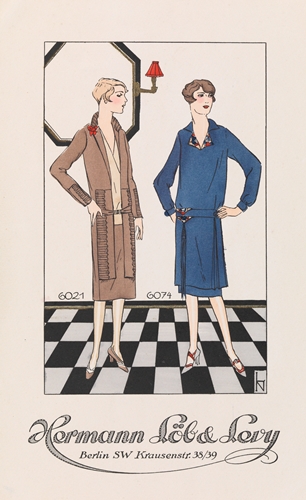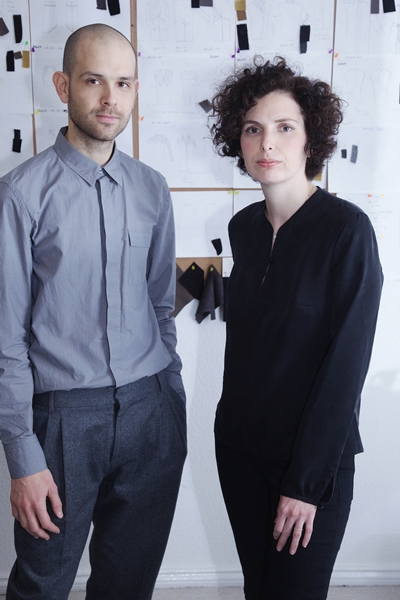Berlin once was a glamorous hub for international style and Jews were part of a thriving business. But the Nazis have almost destroyed fashion and tailoring tradition. Today Berlin ranks again among the top international fashion locations. More people earn their living in the fashion business in Berlin than in any other German city
Rosenthaler Strasse, Mulackstrasse, Alte Schönhauser, Kastanienallee – addresses to set the pulse of any fashionista racing. The reunified and much rejuvenated Berlin has recently established itself as Germany’s fashion capital. Important fashion fairs presenting the best and latest in style have become a regular feature of the city’s packed events calendar.
During Berlin’s biannual Fashion Weeks, ‘Bread & Butter’ assumes control of the old Tempelhof terminal building which was once part of Europe’s largest inner-city airport. Befitting the city’s bohemian, relaxed atmosphere the show targets the more casual, street and urban markets. Fashion Week itself primarily features established international brands.
However, key to the spirit of this Fashion Week are the many young and upcoming designers given a chance to present their wares to a global audience. The booming sustainable fashion market is also an important aspect with the Green Showroom hosting a number of events.
International top five locations
Berlin Mitte, Prenzlauer Berg, Hackescher Markt, the old and new heart of the city is teeming with fashion, state-of-the-art designer shops, glittering flagship stores, avant-garde showrooms, tiny outlets, and studios hiding in backyards. There is a tangible energy swirling around the streets. It should be no surprise that more people earn their living in the fashion business in Berlin than in any other German city. There are nine schools and universities where aspiring designers can learn the ropes. At the moment, Berlin ranks among the top five international fashion locations. This is great news for a city not commonly noted for its elegance and style. Was it always like this?
Dawn of fashion
Almost forgotten these days, Berlin was once a glamorous hub for international style. In the 1830s, the Jewish Manheimer brothers began producing and selling a revolutionary new garment type. Off the peg, ready-made clothes for the masses or Konfektion as the German word would have it. The clothing industry had had its first taste of industrialization.
Up until then, elegant clothes had been a luxury reserved for the bold and beautiful of the moneyed classes. Almost overnight, plentiful supplies of fashionable garments became affordable for the bourgeoning bourgeoisie. Fashion became the new craze, transfixing the city and the continent.
Jewish entrepreneurs set the tone
By the 1850s, more than 800 magazines and periodicals informed style-savvy readers of the latest trends and must-haves. Valentin Manheimer had hit the big time. The ‘King of Coats’ as he became known, shipped his designs all over Europe and as far flung as North America. Based around Hausvogteiplatz in the old center of the old city, the clothing business exploded in hitherto unknown dimensions.
Konfektion became one of the primary driving forces in Berlin’s economy with a booming export market. Nathan Israel, David Leib Levin and Rudolph Hertzog were among the giants of ready-made apparel.
At one point more than 2,400 businesses catered for the insatiable demand for beautiful attire. There was of course a less glamorous side to all this. All those sequins, curves, and bows were being manufactured by around 100,000 seamstresses, many of whom were stitching away in their homes under miserable conditions up to 18 hours a day.
Wertheim’s stores became institutions
There were some success stories though too. Hermann Gerson, formerly Hirsch Gerson Levin, who had started out with ready-made clothes became the purveyor to the court of the German Kaiser. Just like Nathan Israel, Gerson opted for what was then a novel way of bringing fashion and fancy goods to the consumer. Their department stores were to become legendary. Oozing elegance and cosmopolitanism, a visit to these Jewish owned stores was a must for Berliners and visitors alike.
The Wertheim family’s stores were to become institutions across Germany with their Berlin bases on a par with the Galleries Lafayette, Macy’s and Debenhams.
But not everybody who tried his hand thrived in Berlin’s fashion business. The bouncing baby born to Simcha and Anna, tailor and fashion designer respectively, failed to show any talent for his parents’ vocation. Instead, the young man, better known as Ernst Lubitsch, went to America to become one of Hollywood’s greatest film directors.
After World War I
In the years after World War I, a time of economic crisis and inflation in Europe, Berlin was heading the opposite direction and slowly roaring back into business. The Twenties had arrived and dancing was all the rage. Music, entertainment and burlesque shows all required elaborate costumes and chi-chi design. Made in Berlin, one could say. But all those jiggling dancers and revelers also required uncomplicated well-fitting clothes.
Berlin Chic was born – no frills, clear lines, clean-cut, with simple but dazzling designs. Sober and somewhat restrained, in a word: cool. Its most famous ambassador for many years to come was undoubtedly Marlene Dietrich, a notorious vamp and archetypal Berliner. When La Dietrich left Berlin for the United States in 1930, it is said she took more than 20 steamer trunks full of Berlin Chic clothes, created at Hausvogteiplatz of course.
Nazis destroyed Jewish tailoring and fashion
But soon a coarse brown cloth was to stifle all the elegance, avant-garde and entrepreneurship which had characterized the Berlin fashion scene for 100 years. Almost as soon as the Naz
is came to power in 1933 they set about destroying the Jewish tailoring and fashion tradition in the city. The Deutsches Modebüro was established under the auspices of Magda Goebbels, the wife of Hitler’s propaganda chief. Konfektion and Jewish were declared synonymous and it was forbidden to use the term. Even underwear had to be ‘Guaranteed Aryan’.
Then came the great officially sanctioned robbery. The so-called ‘Aryanization’ process drove Jewish owners out of their businesses, firms, and shops. The fashion industry did not escape and Jews were forced to sell under unfavorable conditions or were simply expropriated. There are countless sad tales of greed and deceit where employees changed allegiances overnight and shamelessly enriched themselves to the detriment of their Jewish employers.
The Jews who had helped to make Berlin fashion what it was were persecuted, forced to emigrate, driven to despair, deported, and many were murdered. Hausvogteiplatz, the clothing industry’s centrifuge, was left bereft of its driving force.
Picking up the threads
Walking there today, one gets a sad glimpse of how it once was. An installation of mirrors and names on the stairs leading to the subway commemorate the great Jewish fashion tradition of this square.
It took decades for Berlin to pick up the fashion-thread again. Today, the majority of designers working in Berlin are not natives of the city. Conditions are said to be favorable and conducive to creative business. Israeli born now Berlin-based designer Einat Feiler Zinger points out, materials are cheaper and easier to come by than elsewhere.
She should know, she uses them to great effect for her label Hazlenut. The relatively low rents for studios and work space is also another important argument in Berlin’s favor. The game changer however, both then and now, is the traditional openness of the city. Even the Nazis and later the Communists could not destroy Berlin’s readiness for experiment.
A new label: Eva & Bernard
Berlin is simply the best place to set up a new label, agrees Nait Rosenfelder, who originally hails from Tel Aviv. Contrary to contemporary inclination, Rosenfelder and her husband Roey Vollman did not look for attention by thinking up some abstruse name for their business. They simply picked two ordinary German first names for their label – Eva & Bernard. A good choice it would appear given the reception the Eva and Bernard collection received at last year’s July Fashion Week.
And those famous department stores of Berlin? It is often claimed that KaDeWe, the Kaufhaus des Westens, is Berlin’s only surviving remnant from the heydays of the giant store for luxury goods. This is not quite true. Walk up Rosenthaler Strasse to number 27-31. Here the Wertheim family opened Berlin’s first Spezialgeschaeft für Manufaktur- und Modewaren back in 1870.
They eventually replaced it with a department store which was designed and built just after the turn of the century by the star architect of the time, and Wertheim’s favorite, Alfred Messel. It became a Berlin landmark. While parts of the façade have been reworked, just around the corner in Sophienstrasse you can still catch a glimpse of the original beautiful design. What’s more, the building is located right in the middle of Berlin’s old, and once again new, fashion district.



